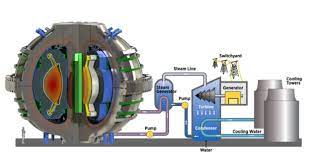
The Department of Energy’s Office of Science published a notice in the March 27 Federal Register calling for input on technological approaches to a Fusion Prototypic Neutron Source (FPNS) for materials irradiation research under DOE-SC’s Fusion Energy Sciences program, as well as partnership models that could accelerate the construction and delivery of the facility. The request for information (RFI) calls for responses by May 11.
Limits of knowledge: Materials inside a fusion energy machine would be bombarded by energetic 14.1 MeV deuterium-tritium fusion neutrons. Managing fusion neutron–induced property degradation is described by the DOE as one of the most significant scientific “grand challenges” facing fusion energy development. But because no facility can yet replicate that neutron irradiation environment, fusion materials research has been limited to the capabilities of fission test reactors, ion beams, and computer simulations, limiting how well researchers and developers can predict and quantify performance degradation.
According to the RFI, “The current knowledge base for bulk mechanical and physical property degradation in a realistic fusion environment with simultaneous transmutation effects is limited.” An FPNS could be used to investigate irradiation effects on both microstructural evolution and bulk material properties degradation. Under the Biden Administration’s decadal vision for fusion energy, the design and demonstration of a fusion pilot plant (FPP) would occur “simultaneously with the design and construction of the FPNS . . . . [T]he results from an FPNS may not directly impact the design and construction of the first FPP but will be critical to later iterations of FPP and eventual licensing of commercial fusion power plants.”
Consensus on the need: Powering the Future: Fusion & Plasmas, a long-range plan developed by the Fusion Energy Sciences Advisory Committee (FESAC) in 2020, included strong support for an FPNS.
“No facility exists that can generate the necessary fluence, energy spectrum, and helium production level in the lattice of candidate materials. FPNS concepts that utilize existing facilities like accelerators or commercial units, combined into a cost-effective system, can be a fast track forward,” the FESAC report stated. “[A]ccelerated access to fusion neutron exposure is an area of extreme interest to the fusion industry and has significant opportunities for near-term public–private partnerships.”
In 2021, the National Academies of Sciences, Engineering, and Medicine (NASEM) released Bringing Fusion to the U.S. Grid, which also emphasized the need for materials research and a neutron irradiation capability to enable a fusion pilot plant.
Performance requirements: In 2022, the Electric Power Research Institute sponsored an FPNS workshop where attendees reached a consensus on support for an FPNS delivered in 2028 or earlier, with future upgrades delivering increased performance capability by 2032 or earlier.
Those timelines are echoed in the RFI. FPNS performance requirements by 2028 or earlier include operation at ~300–1200°C and gaseous and solid transmutant generation rates consistent with 14 MeV fusion neutron delivering 5–11 displacements per atom (Fe equivalent) per calendar year to a high-flux zone sample volume of ≥50 cm3. By 2032 or earlier, the FPNS should be capable of delivering more displacements per atom (15 per calendar year) to a larger sample volume of ≥300 cm3.
The RFI states that “an FPNS will address the fundamental question of whether materials retain adequate properties for damage levels greater than 20–50 displacements per atom in a fusion neutron environment, and lifetime limits from an engineering science perspective at higher levels of irradiation. This will enable the generation of engineering data that is required to design and deploy commercial fusion devices. These roles could be addressed in either the same or complementary irradiation facilities.”
The RFI’s ask: DOE-SC wants information on both technological approaches and potential ways to accelerate the construction and delivery of an FPNS, including public-private partnerships. According to the RFI, “Of special interest are approaches leading to a facility under a total capital cost of $500 million, even if meeting this objective would require upfront R&D.”
Respondents are asked to briefly address nine topics (see the RFI for more details):
Technological approach to meeting the performance requirements.
Technical maturity and risks of the concept.
Research and development required, including rough cost/schedule and milestones.
Estimated capital and operating costs.
Potential for performing accelerated irradiation studies.
Similarity or deviation of neutron irradiation spectrum relative to prototypic fusion device conditions.
Temperature and irradiation flux stability/control.
Ability to perform multiple-effect tests.
Potential commercial partners, markets, and opportunities for public-private partnerships.
Comments may be submitted electronically through regulations.gov, and questions may be submitted to fpns@science.doe.gov or by telephone to Daniel Clark at 240/780-6529.